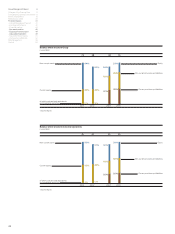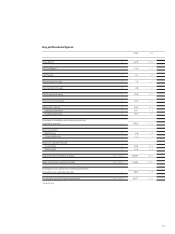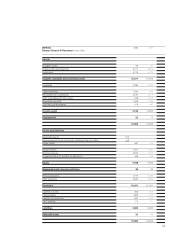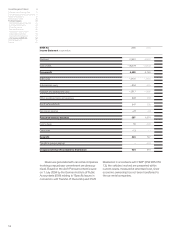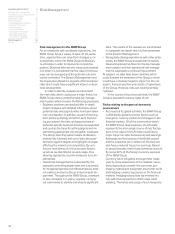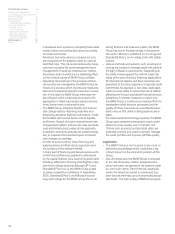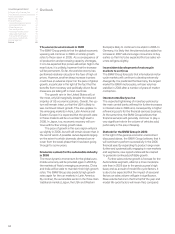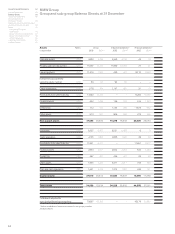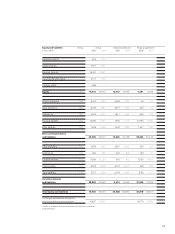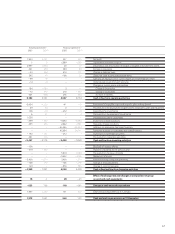BMW 2005 Annual Report Download - page 59
Download and view the complete annual report
Please find page 59 of the 2005 BMW annual report below. You can navigate through the pages in the report by either clicking on the pages listed below, or by using the keyword search tool below to find specific information within the annual report.58
is measured each quarter by comparing forecasted
market values and contractual values according
to model and market.
Provisions and write-downs on leased-out cars
are recognised in the balance sheet to cover all
identified risks. This risk is also reduced by meas-
ures such as active life cycle management and
management of used car markets at an interna-
tional level, both of which have a stabilising effect
on the residual values of BMW Group vehicles.
– Operating risks relating to the provision of finan-
cial services are managed by the BMW Group by
means of a process which records and measures
risks and incorporates specific measures to avoid
risk. In this way, the BMW Group minimises the
risk of losses which could arise as a result of in-
appropriate or failed internal procedures and sys-
tems, human error or external factors.
– The BMW Group mitigates liquidity and interest
rate change risks by matching maturities and
employing derivative financial instruments. Credit
line facilities with various banks ensure liquidity
at all times. As part of a value-based interest rate
management system, interest rate risks are meas-
ured and limited using a value-at-risk approach.
In addition, sensitivity analyses are prepared regu-
larly to measure the potential impact of interest
rate changes on earnings.
– In order to avoid currency risks, financing and
lease business is refinanced as a general rule in
the currency of the relevant market.
A major part of financing and lease business with-
in the Financial Services segment is refinanced
on the capital markets. As a result of its good credit
standing, reflected in the long-standing first-class
short-term ratings issued by Moody’s (P-1) and
Standard& Poor’s (A-1), the BMW Group is able
to obtain competitive conditions. In September
2005, Standard& Poor’s and Moody’s issued
long-term ratings for the BMW Group.Due to its
strong financial and business profile, the BMW
Group has one of the best ratings in the automo-
bile
sector. Moody’s published an A1 rating and
Standard& Poor’s an A+ rating, both with stable
outlook.
– Various methods and systems such as rating and
scoring are in place to manage credit risk, partly in
the light of Basle-II requirements. Depending on
the credit volume applied for and the credit risk
rating of the party involved, financing applications
for international dealers and fleet customers are
presented to the local, regional or corporate credit
committees for approval. A two-step credit appli-
cation process helps to reduce the risk of default
affecting the Group’s worldwide financial services
operations. In another measure to reduce risk,
the BMW Group is continuously making efforts to
standardise credit-decision processes and the
quality of those processes on a worldwide basis,
and to ensure that uniform rating systems are in
place.
For retail customer financing purposes, the BMW
Group uses validated scorecards to reach credit
decisions more quickly and to monitor risk.
Criteria such as arrears and bad debt ratios are
analysed monthly and used to actively manage
the credit portfolio and improve portfolio quality.
Legal risks
– The BMW Group is not involved in any court or
arbitration proceedings which could have a sig-
nificant impact on the economic position of the
Group.
– Like all enterprises, the BMW Group is exposed
to the risk of warranty claims. Adequate provi-
sions have been recognised in the balance sheet
to cover such claims. Part of the risk, especially
where the American market is concerned, has
been insured externally up to economically accept-
able
levels. The high quality of BMW Group prod-
Group Management Report 8
A Review of the Financial Year 8
The General Economic Environment 11
Review of operations 15
BMW Stock in 2005 38
Financial Analysis 41
--Internal Management System 41
--Earnings performance 42
--Financial position 45
--Net assets position 46
--Subsequent events report 49
--Value added statement 49
--Key performance figures 51
--Comments on BMW AG 52
Risk Management 56
Outlook 60


